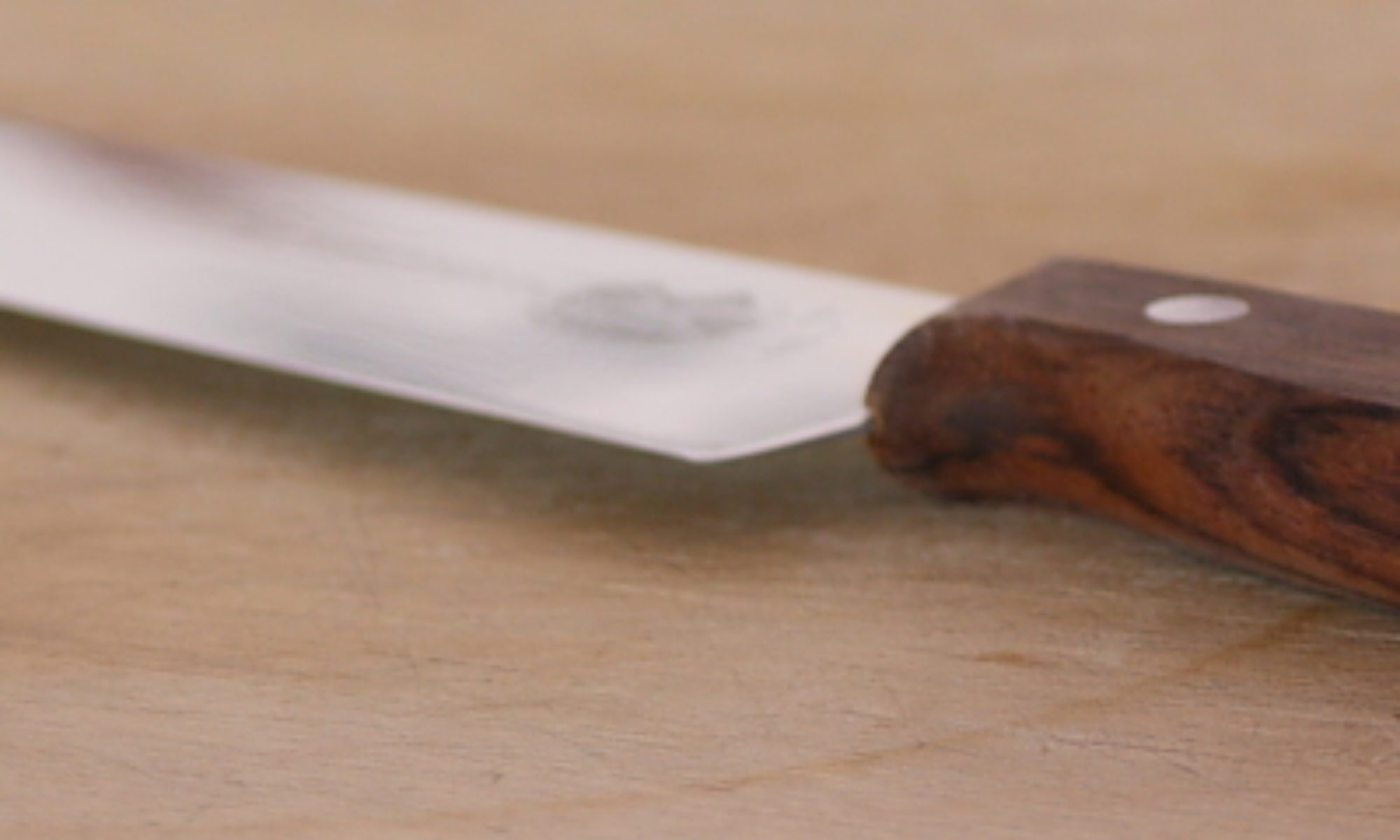
Now, why in the world would anyone want to make ramen noodles from scratch? After all, those things are the ubiquitous staple of college dorm rooms everywhere, mainly because they’re fast, filling, and, most of all, cheap. Very cheap. So, again, why make something that you can buy for less than a quarter?
First, because it’s kind of fun to try something that most people would never even dream of making at home. But, more importantly, we know that noodles have a long and glorious history in the Orient. One that doesn’t always include those brittle packets of squiggly noodles and their obligatory salt packet. Instead, we know that noodles can be good. So, we thought we’d try making some ourselves. Naturally, we hit the Internet and found a recipe (on Lucky Peach) that seemed to fit the bill. We did scale it back so it would be the perfect amount for two, and we’ll also say that you’ll pretty much need a pasta rolling machine for this dough.
Homemade Ramen Noodles
Ingredients
- 20 g baking soda (1/4 cup)
- 50 g hot water (3 Tbs + 1 tsp)
- 50 g tsp cool water (3 Tbs + 1 tsp)
- 200 g all-purpose flour (scant 1 1/2 cups)
Instructions
- Preheat oven to 250°F. Line a baking sheet with aluminum foil for easy cleanup.
- Spread baking soda on lined baking sheet. Bake for 60 minutes. Remove from oven.
- Place hot water in a medium bowl. Sprinkle 2 teaspoons of baking soda over the surface and stir until dissolved. Add cool water and stir.
- Add flour and stir until a dough forms. Turn out onto a clean work surface and knead for 5 minutes. Wrap in plastic and let rest for 20 minutes. Knead for another 5 minutes, re-wrap, and refrigerate for 1 hour.
- Divide dough into four pieces and roll through a pasta machine to desired thickness. Cut pasta using the spaghetti cutter and let dry for 20-30 minutes.
- Bring a large kettle of salted water to a boil. Add noodles and cook 2-3 minutes or until tender but still chewy.
- Serve in warmed bowls covered in a broth soup.
Ingredient discussion:
Who said cooking isn’t chemistry? Baking the baking soda causes it to decompose chemically to form sodium carbonate (washing soda) from sodium bicarbonate (baking soda). Why do you want to do this? It makes the powder more alkaline, which, in turn, breaks down the gluten in flour, making for a more pliable, rubbery, chewy, dough. It also seems to make the noodles slightly slippery, too. All of what you want in ramen noodles. Do note that you won’t use all the baking soda that you bake; you’ll have some left for another batch in the future. And, we think you’ll want to make these again.
Procedure in detail:
Preheat oven to 250°F. Line a baking sheet with a piece of aluminum foil for easy cleanup. It also makes it easy to pour the baked soda into a container later — you won’t use it all for one batch of ramen.
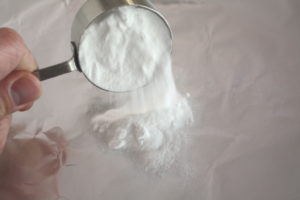
Bake soda. Spread the baking soda on the prepared sheet and bake for 60 minutes. Remove from the oven and let cool. It won’t look any different when it comes out of the oven, but, chemically, it is. It’s no longer baking soda; instead; it’s what’s called washing soda, and it will no longer work for making baked goods rise.
Dissolve. Place the hot water in a medium microwave-safe bowl and sprinkle 2 teaspoons of the baked soda over the top. Stir until it dissolves. You may find that the baked soda clumps into hard lumps. If so, try warming the water a bit further by placing it in the microwave for 20 seconds, and using the back of a spoon to crush the pieces while stirring. Once dissolved, and the cool water.
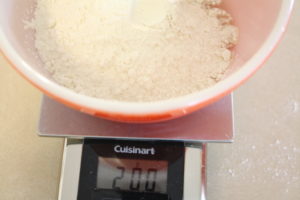
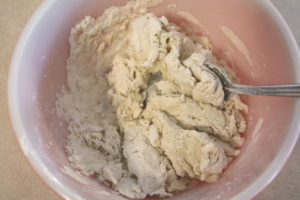
Add flour. Stir in the flour until you have a rough, shaggy dough. It should only take a minute or so.
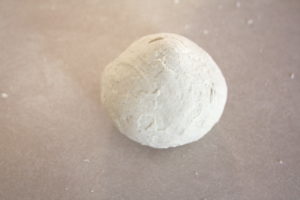
Knead. Turn the dough out onto a clean work surface and knead for 5 minutes. This will be a pretty stiff dough, so it’ll be hard to knead. Harder than kneading bread dough, or even standard pasta dough. You’ll see, but don’t fret, you can do it. We guess that you could knead it in a mixer, but we never bother with such small amounts.
Rest. Wrap the dough in plastic and let rest for 20 minutes. This gives you a chance to rest, too, which is nice.
Knead. Ding! Twenty minutes are up. Time to go back to kneading. At first the dough will seem more supple, but in a minute it’ll tighten and become more of a chore to knead. Keep kneading as best you can for 5 minutes.
Chill. Wrap the dough in plastic and place in the refrigerator to chill and rest for an hour.
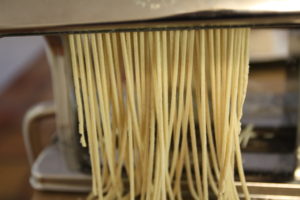
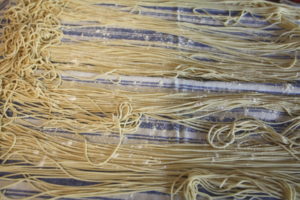
Roll and cut. Divide the dough into 4 pieces, dust with flour, and roll through a pasta machine, adjusting the rollers to make the pasta thinner on each successive pass. If needed, dust with flour to prevent sticking. Once rolled to the desired thinness, pass through the cutter designed for making spaghetti, then place the pasta on a drying rack covered with a clean dish towel. If needed, dust the strands with flour to prevent sticking. While you can boil up the pasta immediately, we like to let it dry for at least 20 minutes to make it easier to handle.
Boil. Bring a large kettle of salted water to a roiling boil. Add pasta and boil until tender but still chewy, 2-3 minutes. Drain completely.
Serve. Sure, we guess that you could just serve this as plain ramen, but we suggest making a light broth with a few vegetables, placing the ramen in heated bowls, covering with your broth, and serving with tamari or soy sauce. We used fresh vegetable stock to which we added a few peas, corn, green onion, mushrooms, and some tamari sauce. It was perfect. You could do the same with simple bouillon, too.
These were great. They have a different texture than our standard pasta made with eggs: chewier, slightly slippery, and, quite like the ramen noodles that come in the package, just better-tasting. We’d guess that they’re healthier, too. We will say that kneading and rolling this dough is a bit more difficult than other pasta dough, but not so much more difficult that it’ll keep us from making these again. Four stars because of the added work.
